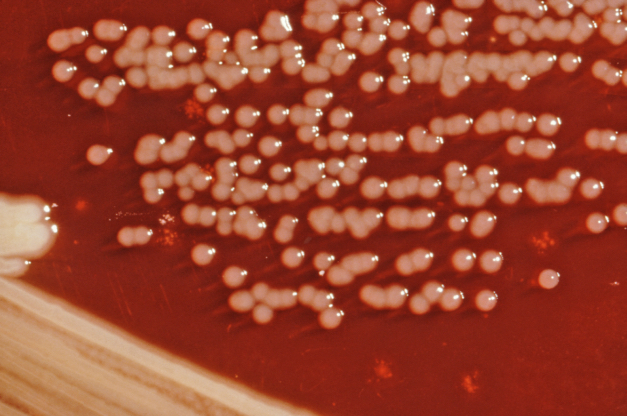Yersinia enterocolitica
| Yersinia enterocolitica | ||||||||||||||
|---|---|---|---|---|---|---|---|---|---|---|---|---|---|---|
 Yersinia enterocolitica colonies growing on XLD agar plates.
| ||||||||||||||
| Scientific classification | ||||||||||||||
| ||||||||||||||
| Binomial name | ||||||||||||||
| Yersinia enterocolitica (Schleifstein & Coleman 1939) |
|
Yersinia enterocolitica infection Microchapters |
|
Differentiating Yersinia enterocolitica infection from other Diseases |
|---|
|
Diagnosis |
|
Treatment |
|
Case Studies |
|
Yersinia enterocolitica On the Web |
|
American Roentgen Ray Society Images of Yersinia enterocolitica |
|
Directions to Hospitals Treating Yersinia enterocolitica infection |
Editor-In-Chief: C. Michael Gibson, M.S., M.D. [1]
Overview
Yersinia enterocolitica is a species of gram-negative coccobacillus-shaped bacterium, belonging to the family Enterobacteriaceae. Primarily a zoonotic disease (cattle, deer, pigs, and birds), animals which recover frequently become asymptomatic carriers of the disease.[1]
Pathogenesis
Acute infections
Acute Y. enterocolitica infections produce severe diarrhea in humans, along with Peyer's patch necrosis, chronic lymphadenopathy, and hepatic or splenic abscesses. Additional symptoms may include entero-colitis, fever, mesenteric adenitis, erythema nodosum and acute terminal ileitis, which may be confused with appendicitis or Crohn's disease. See yersiniosis for further details.
Treatment
Treatment of Y. enterocolitica infections requires aggressive antibiotic therapy, typically involving a combination of chloramphenicol, ampicillin, and polymyxin.[1]
Long-term effects
Y. enterocolitica infections are sometimes followed by chronic inflammatory diseases such as arthritis.[2]
Y. enterocolitica seems to be associated with autoimmune Graves-Basedow thyroiditis.[3] Whilst indirect evidence exists, direct causative evidence is limited,[4] and Y. enterocolitica is probably not a major cause of this disease, but may contribute to the development of thyroid autoimmunity arising for other reasons in genetically susceptible individuals.[5] It has also been suggested that Y. enterocolitica infection is not the cause of auto-immune thyroid disease, but rather is only an associated condition; with both having a shared inherited susceptibility.[6] More recently the role for Y. enterocolitica has been disputed.[7]
External Links
- Genome information is available at the NIAID Enteropathogen Resource Integration Center (ERIC)
Footnotes
- ↑ 1.0 1.1 Collins FM (1996). Pasteurella, Yersinia, and Francisella. In: Barron's Medical Microbiology (Barron S et al, eds.) (4th ed. ed.). Univ of Texas Medical Branch. (via NCBI Bookshelf) ISBN 0-9631172-1-1.
- ↑ Ryan KJ; Ray CG (editors) (2004). Sherris Medical Microbiology (4th ed. ed.). McGraw Hill. ISBN 0-8385-8529-9.
- ↑ Benvenga S, Santarpia L, Trimarchi F, Guarneri F (2006). "Human Thyroid Autoantigens and Proteins of Yersinia and Borrelia Share Amino Acid Sequence Homology That Includes Binding Motifs to HLA-DR Molecules and T-Cell Receptor". Thyroid. 16 (3): 225–236. PMID 16571084.
- ↑ Tomer Y, Davies T (1993). "Infection, thyroid disease, and autoimmunity" (PDF). Endocr Rev. 14 (1): 107–20. PMID 8491150.
- ↑ Toivanen P, Toivanen A (1994). "Does Yersinia induce autoimmunity?". Int Arch Allergy Immunol. 104 (2): 107–11. PMID 8199453.
- ↑ Strieder T, Wenzel B, Prummel M, Tijssen J, Wiersinga W (2003). "Increased prevalence of antibodies to enteropathogenic Yersinia enterocolitica virulence proteins in relatives of patients with autoimmune thyroid disease". Clin Exp Immunol. 132 (2): 278–82. PMID 12699417.
- ↑ Hansen P, Wenzel B, Brix T, Hegedüs L (2006). "Yersinia enterocolitica infection does not confer an increased risk of thyroid antibodies: evidence from a Danish twin study". Clin Exp Immunol. 146 (1): 32–8. PMID 16968395.